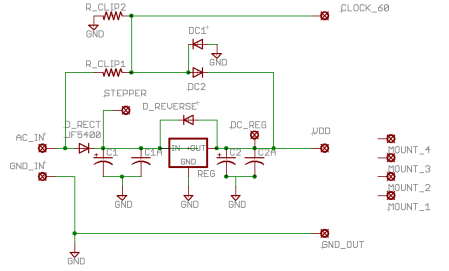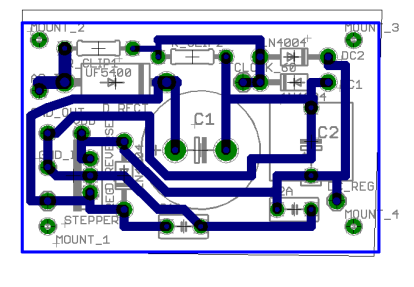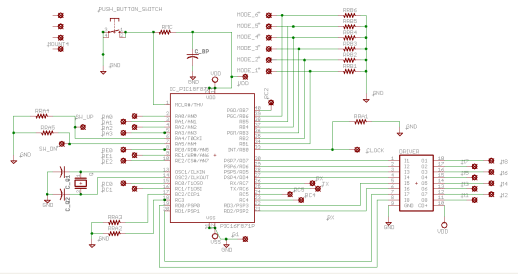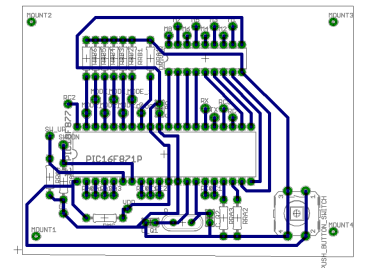PIC based Stepper Motor Dancing Analog Clock
Contents
Summary
- Name: PIC based Stepper Motor Analog Clock with Dancing Hands
- Purpose: An amusing analog clock, see below.
- Status: This is a very early draft. Code works but still in refinement, code available, email russ_hensel
- Technology: Stepper Motors, PIC 16F877A and BoostC
- Author: russ_hensel ( where you can find an email address to reach me )
- License: Open source and object code.
This is an analog clock, with real hands driven by stepper motors. Because stepper motors are quite powerful the clock could be made quite large, 3 feet in diameter is probably within reach still using inexpensive ( salvage ) stepper motors. The project description includes eagle files for the circuits and a BoostC project with source code for the PIC.
Major Parts
- 2 Stepper Motors -- probably can be salvaged from printers or 5 1/4 disk drives ( where I got mine )
- PIC16F877 processor -- Others can be used, but this guy has a lot of IO, quite a bit is used for the clock
- Low sid Driver Chip -- but any transistors with reasonable beta and enough current handling capacity could be substuited.
- Case -- With a bit more work than I have done you could have a really nice case. I am working on an oak one now
- Clock Face -- Some good artwork here could make a really good looking clock, anyone willing to send me an high quality graphics file?
- Circuit Board -- Right now mine is built mostly on a proto board, but I have designed but not tested printed circuit boards suitable for single sided, toner transfer, fabrication.
Features
| Feature | Details |
| Hour hand/ Minute Hand | Hour hand is of conventional layout, but only changes hour on the hour. The minute hand is more like an elevator floor indicator, rotates 180 degrees, moves to the next minute on the minute. |
| Special effects -- Dancing | Hour and minute hands may "dance" at special times, see the video at: xxx |
| Power / timekeeping | Powered from outlets, timekeeping based on the powerline ( which is long term very accurate (( less power outages )) ). |
| Optional Serial Interface | For debugging and demo of special effects
|
Circuit
The circuit does not need much explanation beyond the schematic and parts list. Here is just an overview.
To make it really easy to fabricate the printed circuit boards I seperated the power supply from the processor board.
For parts I used used my junk box, when it fails consider SparkFun and Futurlec. Or..... See: Supplier.
Power Supply
This is a straight forward half wave rectifier with a linear regulator. It is powered by a wall wart transformer rated at about 9 volts. The unregulated voltage is over 9 volts ( 9 * ( 2 ^ 1/2 )) by simple theory. This unregulated voltage is used directly by the steppers so choose you wall wart to match your stepper motors. You should also size the filter caps based on the current that will be used by the motors. A couple of volts of ripple is not a problem as long as you have enough overhead for the 5 volt regulator ( the PIC might run on less, let me know if you try it ). An important part of the power supply is a 60 hz, roughly square wave. It is clipped off from the AC input. The 60 Hz power line tends to be very accurate over the long term, less so if you suffer power outages. You could run the clock on DC but the motors load down a battery pretty badly and you would need a timing signal ( the original code has a subroutine for timing off the crystal ).
Power Supply Schematic and Board
Single sided, for toner transfer, in Eagle ( semi-final, less ground plane, files may be more up to date ) Note that I have included some parts for very conserative design, which I did not in fact use.
Parts
| Part | Details |
| Wall Wart | You need one with AC output to get the 60 Hz timing signal from the power line. Mine is a 9 v 800 ma unit. I found it somewhere. |
| D_RECT = Rectifier Diode | Size for current needed by motors, then say double. Let the reverse voltage be 4 x the input voltage. Mine came from salvage. Look on Instructables.com for similar power supplies. |
| C1 = Filter Cap | My junk box yeilded 4,700 mfd at 25 volts |
| C1A = High Frequency Bypass | .01 to 1 mfd cap with good high frequency response, mica is fine. Electrolytic to be avoided. |
| C2 = Filter Cap | Probably can skip, I did. |
| C2A = High Frequency Bypass | .01 to 1 mfd cap with good high frequency response, mica is fine. Electrolytic to be avoided. |
| DC1, DC2 = Clipping Diodes | Clip the AC for the time keeping to +5 and 0 volts. Protects the input of the PIC. |
| R_CLIP1 R_CLIP2 = Clipping Resistors | 10 k resistors, form voltage divider to the timing signal to PIC, limits current to DC1 and DC2. |
| D_REVERSE = reverse voltage protection diode | Use only if you worry about reverse voltage protection on the regulator. Not real likely, I left it out. |
| REG = 5 volt voltage regulator. | 100 ma seems to be pleanty, use a 1 amp unit if you want. Current is only for the PIC, it is not much. I think the 1 amp unit is the 7805. |
| AC_IN | AC input from wall wart. |
| GND_IN | Other input from wall wart. |
| GND_OUT | Ground out to Processor board. |
| CLOCK_60 | 60 Hz signal to Processor board. |
| VDD | 5 volts to Processor board. |
| MOUNT_1...4 | Mounting holes |
| Stepper | Badly regulated power for the stepper motors, to the common connection on the motors. |
Processor Board
Processor Schematic and Board
Single sided, for toner transfer, in Eagle ( semi-final, less ground plane, files may be more up to date )
Parts
| Part | Details |
| Wall Wart | You need one with AC output to get the 60 Hz timing signal from the power line. Mine is a 9 v 800 ma unit. I found it somewhere. |
| PIC16F877A | |
| MODE_1...MODE_6 = Rotory Switch connections | I used an old Radio Shack 12 position switch only 6 of them are used here. You could use seperate pushbuttons, the advantage is that the position of the rotory switch indicates which mode you are in, else you may want an led for each one, perhaps using another bunch of ports. |
| Single Pole double throw Momentry Switch | ( or could be 2 momentary push buttons ) one moves the hands up, the other down, in the set and adjust modes. |
| Pull Up/Down Resistors | |
| CQ1, CQ2 = crystal resistors | about 20 pf seems to work, see the 977a manual |
| xx | |
| xx | |
| Q = crystal | 4 meg Hz is what I used. May be quite a bit faster than needed, I have not looked into this. The 4 meg crystal seems to work ok on a proto board. |
| RA4, RA5 = Pull up resistors | 10K |
| RB1 ... RB6 | |
| RRA2, RRA3 = | |
| C_BP = By Pass Cap. | .01 to .1 mfd mica or other by pass cap, good at high frequency seems good. |
| RRA1 = | |
| CLOCK = | |
| DRIVER = | Driver chip for stepper. ULN2803 |
| RMC = Pull up resistor for master clear | 10k |
| PUSH_BUTTON_SWITCH = Reset | Push to reset the processor. Mine was from salvage. |
| = | |
| = | |
| = | |
| = | |
| = | |
| CLOCK = Clock input signal | Connect to CLOCK_OUT on power supply. |
| VDD = | |
| G1 = | |
| SW_UP, SW_DOWN = | |
| = | |
| = |
Program
Nothing very fancy here. The 60 Hz input is fed to the port x interrupt. This lets the PIC keep time. The hands are not moved during the interrupt instead flags requesting hand movement are set and the main loop moves the hands.
Invalid states for the mode can easily happen with a rotory switch when the wiper is not fully in position. Because of this not all possible states on the mode input are used.
The stepper control is half step. The activation of the coils is determined by an array which hold the 8 different activations of the coils.
For the serial interface code see Serial Communications Library -- BoostC and 16F877A
Additional Ideas
- Add a chime perhaps using an D to A converter and small amp and speaker.
- Add an LED to show the clock is powered or running, make blink at 1 hz if that pleases you ( I do not like the blink ).
- Work on more dances.
- The mode control is based on inputs that are pulled down, the chip has an option for weak pull up on the port, using this and pulling down with the mode switch would get rid of a bunch of resistors on the board.
- Add battery backup to keep the internal time ( but not the hands ) running during a black out.
- Make it really big; the motors would probably drive a 3 foot diamater unit.
- For a related project see: Stepper Motor Tester
Download
Comming, email me until then see [[russ_hensel]
Comment, Questions, Contributions?
Email me russ_hensel, or use the talk page for this topic. All feedback is welcome.



